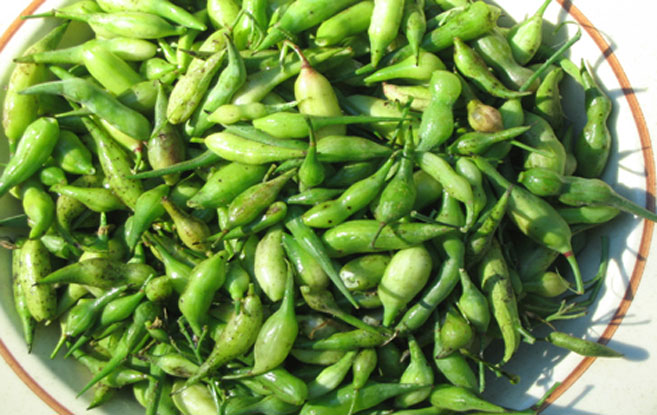Invasion of the Radish Pods
On farms and in vegetable gardens we rarely let radish plants engage in reproduction. Before they flower they are uprooted and, well, eaten. Some people prefer the raw peppery root and some like to cook and eat the leaves of this annual. Most of us are familiar with the rapid-developing (about a month) smaller types like Cherry Belle, a common supermarket selection. These are members of what is known in the radish world as spring-planted varieties. Among the spring-planted radishes, the skins of the root can be white, red, purple or black.
Winter radishes, in contrast, are sown in late summer and two months later produce a prodigious root, in some cases the size of a medium turnip or a parsnip. As with the foregoing root crops, these radishes can be stored during the winter. Their roots can also be pigmented, like the Black Spanish, but most familiar are the white daikons.
Radish culinary uses are broad but they have reached their apex in Asian cooking. In fact, the best botanical evidence suggests that wild radishes had their origin in Asia and spread westward, gaining popularity as an important peppery food and for their imputed medicinal qualities as an aid to digestion and an anti-scurvy food. According to William Woys Weaver in his book Heirloom Vegetable Gardening: A master gardener’s guide to planting, growing, seed saving, and cultural history (New York: Henry Holt and Company, 1997), radishes were once served at every meal in colonial America.
I initially grew radishes in our vegetable garden as companion plants. These fast-growing plants provide shade and break up the soil for the neighboring bush beans, lettuce and chard. On Cape Cod, spring varieties of radish can first be sown in March and eaten in about 30 days; thereafter, they can be sown every two to three weeks until August, as I did. This planting schedule produced a lot of red radishes, some of which I gave to friends.
After reading in Weaver’s book that some radishes have been selected for producing edible pods, like the rattail radish (the worst name for a vegetable, according to farmer Weston Lant of Lucky Field Organics in Rochester, Massachusetts), I declared a stay of execution for those remaining red radish plants. These plants were permitted to flower, hopefully to be insect-pollinated (they don’t self-pollinate) and then form seed pods. Eventually, each white flower produced a green pod one to two inches long. Later, in August, I sowed white icicle radish seeds and let them also flower and form pods; these were almost three inches long and a little plumper.
As the red radish pods grew from pea size to maturity, I plucked some from the plants to taste and to determine the best harvest time. Eaten raw, I preferred the peppery young, firm green pods and avoided yellowing or soft pods. The raw crisp pods of the icicle radish, in contrast, were more peppery than the red radish pods. Radish pods are fun to snack on; they also perk up a salad and complement soft cheeses and yogurt. Pods can be stored dry in a breathable plastic container in the refrigerator for up to a week.
A quick pod sauté produced great results. Move a handful of dried green radish pods with the stems removed around a non-stick sauté pan coated with oil over medium-high heat for two minutes. Remove, sprinkle with sea salt and munch. These can be served separately or combined unsalted with other ingredients in a stir-fry.
Meanwhile, as spring gave way to summer, the red radish pods were piling up. What was I to do with them? Pickle them. Curing the pods took several months and I was encouraged by the results. They tasted like peppery cucumber pickles. Pickled pods can be eaten plain, used in a relish and added, for example, to a frittata.
Pickled radish pods can also substitute for capers, the pickled bud of a perennial plant that flavors cuisines of the Mediterranean region. So I did a comparison test. I made an Italian green sauce (garlic, parsley, salt, pepper, lemon zest and olive oil), adding capers, the traditional ingredient, to one sample and pickled red radish pods to another. By themselves, I preferred the peppery radish pod version of the green sauce to the caper version. And accompanying lamb stew and gnocchi Romano the radish pod version of the green sauce really shone.
I let some of the pods mature on the radish plants until they were pregnant with seeds and had turned from green to tan. These pods do not open to shed the seeds. After drying them indoors for two weeks and extracting small brown seeds, I tested their viability by putting some within a moist folded paper towel in a closed plastic bag. In about a week at room temperature some of the seeds had germinated. I then planted one of the seedlings and watched it reach upward toward the grow lights. Now I don’t have to buy red or icicle radish seeds for 2011, but since radishes hybridize I’m not certain what forms will appear in the garden.
Spring is here and with it an opportunity for the radish pod invasion to expand. As soon as the soil warms I’m going to sow rattail radish seeds. These heat-tolerant plants grow several feet tall and produce many long edible pods in about fifty days. In the summer I’ll sow Munchen Bier (Munich Beer) radish, a winter variety, which are grown for their peppery pods and whose thinly sliced root traditionally is smeared with soft butter and washed down with a stein of beer.
Les Garrick is a writer, video producer and vegetable gardener living in Woods Hole. His current interests include the future of wild beach plums; a history of Hatchville, a village of Falmouth; and local food security.





